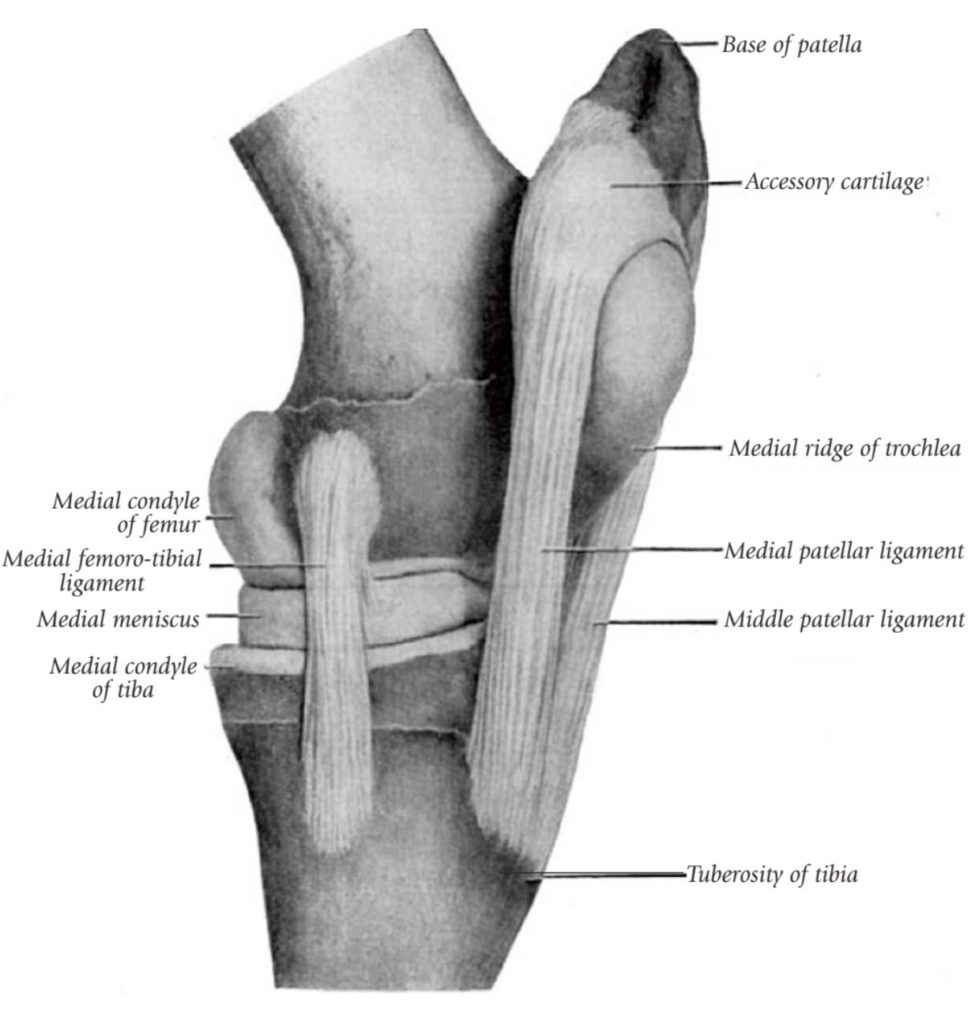The stifle is the horse’s equivalent to the human knee, and is therefore the junction between the bottom of the femur and the top of the tibia.
The patella (knee cap) is a mobile structure that glides over the joint surface during locomotion, but can also be locked in position by various ligaments and tendons.
In the normal horse, the patella’s function is to sometimes ‘lock’ in an upward position when the medial patella ligament hooks over a ridge on the end of the femur. This is the reason that horses can sleep standing up, or rest one leg for long periods. When the horse steps forward, the patella is released from the inside of the medial trochlear ridge, allowing the limb to flex. Problems occur when the patella gets ‘stuck’ in the upward position; this is termed upward fixation of the patella (UFP) or a locking stifle. When the patella fails to disengage from the bony ridge, the leg remains extended, giving the characteristic stance seen in horses with a locking patella.
When the patella locks during work the horse may drag its toe. Backing the horse will often remove the tension from the ligament and cause the patella to release. In severe cases the leg can remain stuck in extension, however the condition is often more mild and will appear as intermittent hopping as the patella catches and then unlocks during the stride.
Causes
UFP is incompletely understood, but thought to be caused by a number of factors including hindlimbs with a more upright (straight) conformation than is ideal. Young horses, or those that are unfit or in poor body condition, can lack the muscle tone required to tighten the medial patella ligament, which can result in UFP.
Diagnosis
Your veterinarian may diagnose this condition by ruling out other conditions such as stringhalt (which causes exaggerated jerking movements of the hind legs), fractured bones, foot abscesses, and other causes of abnormal gait in horses. The veterinarian will often use imaging such as x-rays to rule out other problems associated with the stifle, and may confirm the diagnosis by being able to manually lock the hindlimb in extension, which should not be possible in a normal horse. Alternatively, many horses are diagnosed by the characteristic gait they exhibit, with a hind limb ‘catching’ as the horse walks.

Treatment
Most horses will respond favourably to training and conditioning to increase strength and coordination of the quadriceps muscles. Swimming is often a productive option for this kind of conditioning. Most young horses with UFP will grow out of the condition with exercise and developing muscles. Specific exercise such as hill work at both walk and trot, and working on different surfaces can help to increase muscular strength and coordination. Historically administration of anabolic steroids in order to promote muscular growth has been used, however this is no longer appropriate in most equestrian applications.
Remedial farriery can be incorporated into conservative treatment by having the inside wall of the hoof trimmed and applying a lateral heel extension, in order to encourage a wider stance with increased loading on the lateral aspect of the limb.
If conservative therapies fail to resolve or significantly improve the problem, there are a number of more invasive options that your veterinarian can offer:
- Injection of counterirritants such as iodine into the middle and medial patella ligaments in order to cause inflammation and scarring reduce elasticity of the ligament
- Ultrasound guided desmoplasty (ligament splitting) of the medial patellar ligament in order to create localised scarring to reduce elasticity
- Medial patella ligament desmotomy (cutting the ligament) can be performed to allow the patella to move over the medial trochlear ridge

Title: The Anatomy of the Domestic Animals Author: Septimus Sisson Publisher: W.B. Saunders Company, 1914
Prognosis
Many horse that experience upward fixation of the patella will experience improvement or resolution of the condition with conservative treatment. In our experience, horses that do not respond to conservative therapy will respond well to cutting of the medial patella ligament. Of those horses that do require more invasive intervention, current literature reports a prognosis of 97.6%.
Buying a horse with patellas
When looking to buy a horse, regardless of issues you may be screening for, riding a horse in the conditions and discipline in which you intend to use the horse, when it is in full work, at all gaits is an important step before having your veterinarian perform the pre-purchase examination. If you notice any issues you would like to investigate or clarify regarding the horse, whether they are conformational imperfections or potential problems, you can discuss these with your veterinarian prior to them performing the pre-purchase examination.
This article, authored by the Darling Downs Vets, appeared in the June 2018 edition of Horse Deals magazine, Australia’s premier horse magazine. This is general advice, so please ring us if you have any specific questions about this or other veterinary issue.

